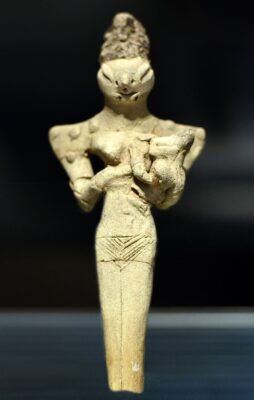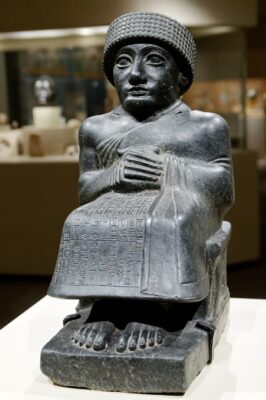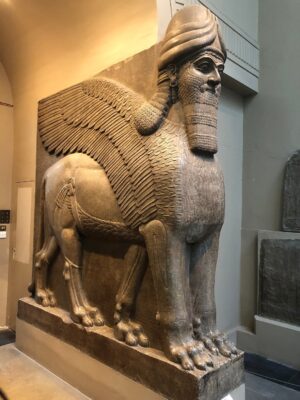Arte de Mesopotamia
La tierra entre dos ríos
La escritura es la madre de la elocuencia y el padre de los artistas
Antiguo proverbio babilónico
Imágenes: «Mujer-lagarto» amamantando a un niño, de Ur, Irak, c. 4000 a.C. Museo de Iraq. Foto de Osama Shukir Muhammed Amin ·· Estatua de Gudea, c. 2144-2124 a.C. Museo Metropolitano. Foto de Marie-Lan Nguyen ·· Toro alado asirio (lamassu), 865-860 a.C. Museo Británico. Foto de Sanjar Alimov
Mesopotamia, la tierra entre ríos, fue el lugar de nacimiento de algunos de los grandes hitos de la humanidad, como la agricultura, la rueda, y posiblemente la escritura. En palabras del historiador Paul Kriwaczek, «si la historia, según la mayoría de las definiciones, comienza con la escritura, entonces el nacimiento, auge y caída de la antigua Mesopotamia ocupa la mitad de toda la historia«.
Al contrario que el Antiguo Egipto, que mantuvo durante su historia una relativa uniformidad cultural, Mesopotamia fue un crisol de pueblos de distintas características, como los sumerios, los asirios, o los acadios, entre otros. Además, el intercambio cultural (voluntario o no) con otras civilizaciones, como la fenicia en el oeste y la persa en el este, resultó en una variedad artística mucho mayor que la producida a orillas de Nilo. De hecho, en la historia del arte la importancia de Mesopotamia no tiene nada que envidiar a la de Egipto, si bien su fama entre el gran público es inferior a la de “el don del Nilo”.
Si bien la arqueología moderna ha realizado grandes hallazgos que permiten comprender cada vez más la historia y el arte de Mesopotamia, los múltiples conflictos bélicos y la inestabilidad política de la zona han destruido irremediablemente algunos de sus testimonios más notables, además de provocar el saqueo de una enorme cantidad de obras.
G. Fernández · theartwolf.com
Follow us on:



